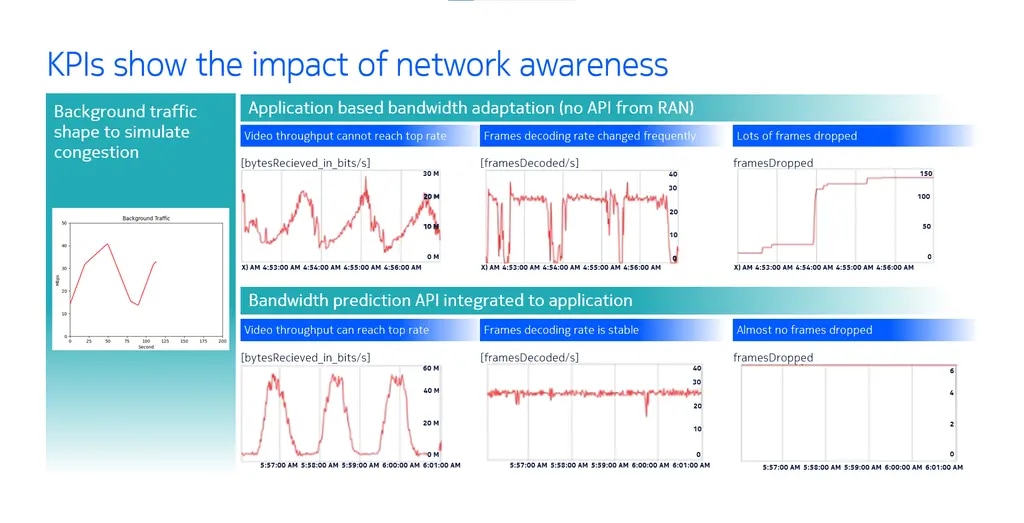Nokia and Elisa optimize video streaming in crowded venues with network exposure

As 5G networks continue to evolve, have you ever wondered what powers your seamless streaming experience, even during peak traffic? There are many QoS methods in the market, but Network Application Programming Interfaces (APIs) bring programmability and network awareness to over the top (OTT) applications. For application developers, these APIs are unlocking network capabilities to deliver exceptional user experiences. Nokia is actively working on network exposure through APIs, our platform “Network as Code" and industry initiatives such as GSMA Open Gateway and CAMARA, earning “Overall Leader & Top Innovator” recognition from ABI Research.
But are we tapping into the full potential of APIs? Core Network APIs already enable critical functionalities such as customer identity verification, banking credentials, and location services. Meanwhile, Radio Access Network (RAN) APIs focus on optimizing Quality of Service (QoS) management and network slicing. These advancements are reshaping connectivity in ways that directly enhance how we experience digital content while also enabling Communication Service Providers (CSPs) to monetize these differentiated experiences.
A game-changing Proof of Concept
Imagine streaming your favorite live sports event or doing real time monitoring of critical industrial process. What happens when network congestion threatens to disrupt your viewing experience? To address this challenge, Nokia and Finnish CSP, Elisa, conducted a successful proof of concept (PoC) to optimize video streaming. This solution leveraged RAN APIs to provide near real-time bandwidth prediction and adaptation, creating a breakthrough for both CSPs and application developers.
Using the Nokia Realtime eXtended Reality Multimedia (RXRM) a 360-degree video of an ice hockey event at the Nokia Arena in Tampere, Finland was streamed over a 5G network. The PoC integrated a near real-time 5G bandwidth prediction API from radio network, enabling the RXRM application to dynamically adjust video bitrate based on available bandwidth.
During the trial, video was transmitted to the device at a throughput of 50 Mbps, with video quality evaluated under varying network loads. The solution demonstrated consistent performance across both scenarios, with the generated background traffic providing a clear basis for comparison.
When 5G bandwidth was abundant, the video quality was perfect. However, as network congestion increased due to rising background traffic, video quality began to suffer, manifesting noticeable jittering and occasional playback interruptions during extreme congestion situations.
Here’s where the 5G bandwidth prediction API made a difference. Once integrated, it allowed the RXRM application to adapt in real time, dynamically adjusting the video bitrate based on bandwidth estimates. This minimized frame drops and ensured an optimized streaming experience, even during congestion.

Figure 1 Nearly double capacity and no dropped frames with bandwidth prediction.
By using predicted bandwidth availability in near real time, the RXRM application ensured a successful video streaming experience for end users. The KPIs revealed that throughput closely tracked available bandwidth, demonstrating consistent performance across both arbitrary and self-generated network loads. Our PoC has highlighted benefits for applications and content providers via better end user experience. By delivering enhanced streaming experiences, CSPs can create business models to monetize differentiated connectivity more effectively, guarantee more efficient bandwidth utilization and avoid waste due to abandoned videos.
Why video streaming optimization matters
With over 70% of mobile network traffic being video, optimizing streaming experiences is vital for both CSPs and application developers. High-motion applications like sports streaming, autonomous driving, and telerobotics demand real-time video with reliable connectivity and adaptive solutions for seamless performance.
A constant bitrate is often insufficient, as varying network conditions can degrade video quality. Many multimedia applications require a deeper understanding of network connectivity to adapt in real time. Several existing methods—such as in-device optimizations, multimedia computation applications and mobile network features—are already being leveraged.
The key gain from bandwidth prediction is its ability to anticipate congestion before it impacts the user experience, delivering more stable video quality even under fluctuating network conditions.
Nokia has also been researching different mechanisms to mitigate network congestion, one of which is Low Latency, Low Loss Scalable Throughput (L4S) technology, developed by Nokia Bell Labs, and successfully tested across 5G networks at the Nokia Arena in Finland.
Looking forward: Collaborating for innovation
Nokia’s and Elisa's successful PoC on video streaming optimization showcases the immense potential of exposing RAN APIs for real-time applications. By enabling adaptive solutions, CSPs can enhance user experience and mobile broadband monetization.
At Nokia, we are committed to empowering CSPs and application providers to deliver a premium mobile experience and discover innovative ways to offer and monetize differentiated connectivity in collaboration with the ecosystem.
For further reading, please take a look at our Programmable Networks and L4S webpages.


